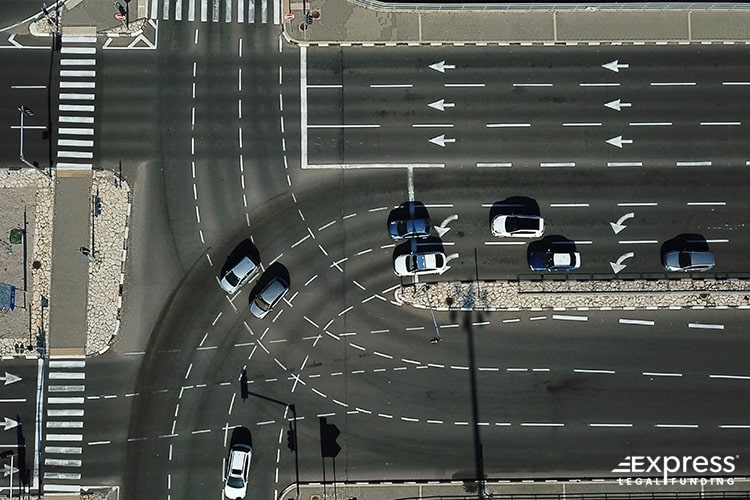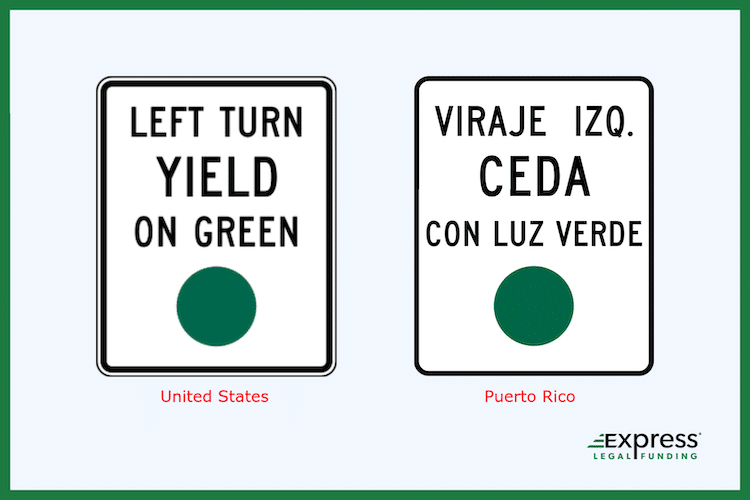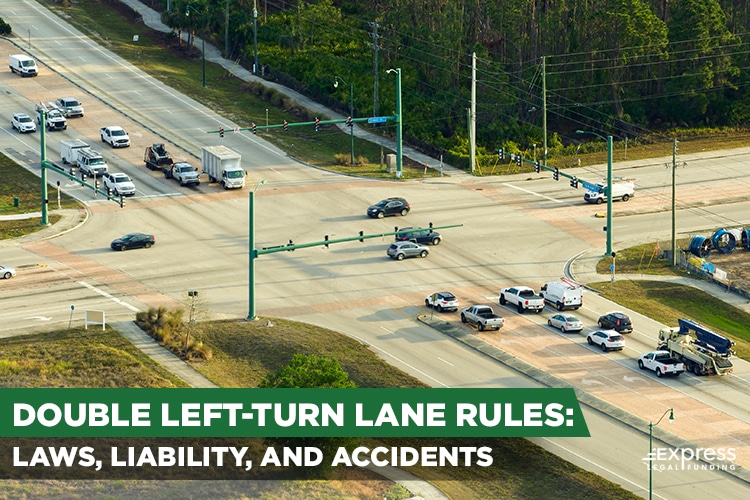
Nowadays, you will be hard-pressed to find an area in countries like the United States that is inaccessible by road.
Even the smallest of towns have at least some form of a road traversable by cars.
So now more than ever, people don’t need to ask whether a remote area has roadways.
Instead, questions about the material (i.e., dirt or concrete paved roads), speed limit, and the number of lanes on the road are what are most applicable.
All of which come with legal implications that inform us of how to drive.
Generally, higher-population areas have larger roads with more lanes to allow traffic to flow better with fewer delays while controlling where vehicles can move.
One type of road feature you will likely encounter in large towns and cities is two lanes for turning left. They double the number of cars that can make left turns at the same time (side by side) at an intersection.
Having two left-turn lanes considerably improves traffic flow by reducing congestion at intersections.

However, if you haven’t seen them before and don’t know the proper protocol, these layouts can be confusing and might cause problems and make traffic worse.
It’s essential to know about double left-turn lanes for safe driving, and this knowledge is more applicable than ever.
Still, like many other types of traffic laws, the rules for these lanes can change depending on the state, which also impacts who is at fault when a car accident happens.
So, it’s crucial for drivers to understand what their local traffic rules are. When drivers stay in their lanes and follow proper turn sequences, they significantly reduce the risk of causing accidents.
Say, for instance, the following example.
There’s a crash on a roadway that allows two left-turn lanes to turn at the same time. Identifying who caused the crash might be challenging. It could depend on state laws, what witnesses say, and if there’s any traffic cam footage of the accident.
Whether you are new to being behind the steering wheel or an experienced driver, knowing and following the double-turn lane laws prepares you to be a better driver.
Statistics show that most auto accidents are preventable and include one negligent driver who is at fault for causing the crash, including double left-turn lane crash incidents.
Based on knowing this and our experience as a pre-settlement funding company with a particular focus on car accident cases, we created this guide to help you stay safe and know who would be to blame if an accident happened involving double left-turn lanes.

Simply put, the information we give you below is written to give you an easy-to-understand explanation of the laws.
That includes details to help you know how to stay safe when making left turns in double-lane situations and how the whole system works in general.
Let’s start by defining what and how double left-turn lanes are supposed to work.
What Are Double Left-Turn Lanes?
Double left-turn lanes are a type of auxiliary turn lane and often appear on busy streets and intersections. They allow for two rows of vehicles going in the same direction to make a left-hand turn at the same time.
This multiple dedicated turning lanes system enables more cars to queue up to wait to make a left turn at a traffic signal, helping to make traffic flow smoother and roadways safer.
How Double Left-Turn Lanes Work
Although the overall concept of two left-turn lanes sitting beside each other is pretty simple, there are optional turn-lane variants that drivers must keep in mind.
Combined Left-Turn Lanes

At certain intersections in some states, drivers in the left lane can opt to turn left or continue straight across the intersection.
These are known as combined left-turn lanes and come with a unique traffic symbol.They can also be the right adjoining lane in double left-turn lanes.
Types of Double Left-Turn Lanes
The two most common types of combinations for double left-turn lanes include the following:

- Both left lanes are only allowed to turn left at the intersection. In the United States, these traffic signs include two left-hand arrows separated by a line with the word “only” written in all capitals below each.
- The far left lane must turn left. The lane directly to its right is a combined turn lane, allowing drivers to turn left or continue driving through the intersection.
In the United States, traffic signs for these types of double left-turn lanes consist of a left-hand arrow with the word “only” underneath it, separated by a line from the combined left-turn and through arrows on its right.

Now that we have discussed the different types of arrows for left-turn lanes let’s focus on the other crucial road marking types that you can find with these dual-turn lanes.
Solid White Lines Between Lanes of Traffic
Solid white lines pavement markings are placed in the space leading up to intersections and pedestrian crosswalks and separate the two left-turn lanes from each other and the adjacent center lane to their right.
Cars are not allowed to cross these solid white lines into another lane unless it is to avoid a hazard on the roadway.
Single-Dashed White Lines Between Lanes of Traffic
White dashed lines are placed in the pavement, forming a leftward arc across the intersection to separate the two double left lanes.
They are made to be turning path guides to help drivers stay in their correct lane while making left turns at intersections.

Government manuals like the Michigan Traffic Control Devices Manual encourage jurisdictions to implement this two-lane setup.
What Are the Benefits of a Double Left-Turn Lane?
There are more benefits to double left-turn lanes than extra efficiency. Designating extra lanes specifically for turns also makes roads safer.
Double left-turn lanes help lessen the odds of common rear-end fender-bender accidents that can happen when a road does not have any dedicated left-turn lanes.

Safety comes first when you drive, and abiding by roadway rules is a big part of that.
Awareness of these double-lane roads can cut down on auto accident risks.
Stick to your lane and use those blinkers. Keep an eye out for others on the road, and be thoughtful. By following these steps, you can reduce the chance of serious trouble!
How To Use a Double Left-Turn Lane?
Many cities have streets with double left-turn lanes to speed up traffic flow by enabling two cars to turn left simultaneously.
Some drivers might find these lanes confusing to use if they lack experience or are unaware of how these multiple-turn lane intersection rules work. That is what we are here to explain.
Double Left-Turn Lane Rules
The number one rule that applies to all double-turn lane situations is to stay in your lane while doing the turn.
Changing lanes while crossing an intersection with multiple turn lanes is not only a traffic violation but is dangerous.

Illegal lane changes can lead to many types of car accidents (i.e., chain-reaction accident or head-on collision).
Always Use Your Turn Signal Before You Make Turn
Before approaching the intersection to make a left turn, you must use your turn signal to let other drivers know you plan to turn at the light.
Is It Illegal Not To Use Turn Signals?
Yes, it is illegal not to use turn signals when moving lanes and turning. Turn signals are not optional.
Most state laws require you to tap your blinker at least 100 feet away from where you will make the driving maneuver (turning or changing lanes).
It’s important to note that the minimum distance requirement for turn signals is 200 feet in some states, with Indiana passing a new law increasing it to 300 feet for drivers traveling at 50 mph and above.

Red Lights and “No Turn On Red” Left Arrow Signs
For double left-turn lanes, a red light means you are not allowed to enter the intersection to make your turn.
Before proceeding into the intersection, you must wait behind the crosswalk for the red traffic signal to change to either a green arrow or a solid green light (yield).
Can You Turn Left On Red On a One Way?
Yes, drivers can turn left on red in the majority of the U.S. states if they are currently on a one-way traffic street and are turning onto another one-way traffic street, except if the intersection has a “No Turn On Red” sign.
When a left turn on red is allowed, the red light acts as a stop sign.
The only U.S. states with a complete ban on drivers making a left turn on red include:
- Connecticut
- Maine
- Missouri
- New Hampshire
- New Jersey
- North Carolina
- South Carolina (unless allowed by local legislation)
- Washington D.C.

These five states allow drivers to turn left onto a one-way street even from a two-way traffic road:
- Alaska
- Idaho
- Michigan
- Oregon
- Washington
Green Arrow: What Is a Protected Left-Turn?
An illuminated green arrow means you can turn left without yielding to oncoming traffic at an intersection, which is known as a protected turn.
When you have a green left-turn arrow, the cars and trucks coming from the opposite direction are responsible for yielding to you since you have the right of way, allowing you to make a left turn safely.
“Left Turn Yield On Green:” What Is an Unprotected Left-Turn?
A solid green traffic light signals that you can go ahead and make your turn as long as there is no oncoming traffic that would make it unsafe to cross. This is known as an unprotected left turn since you must yield to the oncoming drivers who have the right of way before turning left on green.

Can You Make a U-Turn In a Double Left-Turn Lane?
As long as there is no “No U-Turn” sign present at the intersection and there is a green arrow or solid green light (yield to oncoming traffic), you can make a U-turn from a double left-turn lane.
Optimally, you want to make a tight U-turn and not swing out too far when you make the 180-degree turn by keeping your car close to the median.
However, your ability to make a tight U-turn will change based on your car’s turn radius and if you face slippery weather conditions on the road (less traction).
Completing a U-turn on a motorcycle, even when legal, can be tricky.
Can You Make a Right Turn From a Left-Lane?
No, making a right turn from a left lane is always illegal. So unless your vehicle is in the furthest right lane, you cannot turn right at an intersection.

Remember: knowing the laws and procedures for how to use double left-turn lanes is just one part of staying safe on the road.
It’s essential to watch for pedestrians in crosswalks and be a defensive driver prepared to avoid other cars making sudden and unlawful moves.
Leaving your designated lane can lead to confusion or, even worse, a car crash.
The National Highway Traffic Safety Administration (NHTSA) strongly emphasizes this point in its driver education programs.
Our next question is: how do you determine who is responsible when you get in a car accident from a double left-hand turn lane?
Who’s Liable In Double Left-Turn Lane Accidents?
Although figuring out who’s to blame in car accidents involving double left-turn lanes can be a headache, with a lot of finger-pointing between drivers, it is entirely possible.
Generally, the driver of the car that moved out of its lane while making a left turn is the party responsible for causing a car accident collision since they committed a traffic violation.

Proving who is at fault can get tricky if both left-turning vehicles leave their lanes at the same time before colliding (or both motorists say the other moved out of the lane, but not them.)
How To Win a Left-Turn Accident Case?
It’s crucial to gather evidence to win a left-turn accident case, which in part begins by contacting the police to let them know what happened and jotting down the contact info of the witnesses whose statements are in the police report (witness testimony such as an affidavit is a form of evidence).
Having evidence, like pictures or traffic cam footage from the crash scene, can be a game changer for your case.
Hire a Left-Turn Accident Lawyer
The best way to win a left-turn car accident claim and compensation for your loss from getting hit by a turning vehicle is to hire a car accident lawyer.
That begins with contacting a car accident attorney or law firm for an initial consultation and free case review. This is a critical step in understanding your legal options.
Many personal injury attorneys specialize in auto accident cases and can provide you with the legal advice and representation you need to prove the other driver and not you caused the left-turn collision.

They understand how traffic laws can affect your case and go over all the evidence with a fine-tooth comb.
From handling the insurance companies, plotting out legal strategies, or pushing your injury claim through the court system, the best car accident attorneys make sure your case gets the focus and expert knowledge it needs to succeed.
Ultimately, knowing the rules of the road is essential when working out who’s to blame.
Obvious things like speed limits, stop signs, flashing red (or flashing yellow light traffic signals), DUI, and whether a vehicle had the right-of-way or was in the wrong lane of traffic need to be considered.
Each kind of accident has a unique set of legal problems, and that’s why it’s crucial to get advice from an expert personal injury lawyer who knows how to handle the ins and outs of a left-turn crash.
Their legal knowledge is very valuable when it comes to understanding the finer points of motor vehicle laws and ensuring their injured client’s rights are protected.
Examples of Double Left-Hand Turn Accidents

Accidents involving double left-turn lanes can show up in different situations, and each creates unique difficulties in figuring out who is to blame and why.
Here’s a look at some common left lane accident scenarios:
When Both Cars Are Turning Left
When two vehicles in parallel left-turn lanes collide at intersections, this is usually because one or both drivers stray from their lanes.
Figuring out who’s at fault demands a close look at the road markings, traffic signals, damage to the cars, and the position of both vehicles when the accident happened.
Left-Turn T-Bone Accidents
T-bone collisions involving left-turning drivers and oncoming traffic are also common. These crashes can happen when drivers misjudge how fast oncoming vehicles are traveling.
Who Is At Fault In T-Bone Accident?
To determine who’s to blame in a t-bone accident, there needs to be a review of rules that dictate which car had the right-of-way. The at-fault party can change based on whether there was a green arrow or a solid green light at the time of the crash.
Left-Turn Motorcycle Accidents
Motorcycles, bicyclists, and e-scooters face more risk when riding in double left-turn lanes.
One common type of motorcycle accident situation is where the other vehicle turning left doesn’t notice the smaller, less obvious motorcycle or bicycle and crashes into it.
Motor vehicle blind spots pose an extra danger for these two-wheeled vehicles mid-turn.
Car Rear-Ended While Turning Left
A rear-end accident can happen while a vehicle turns left if it suddenly stops and the vehicle behind it can’t stop in time (often due to distracted driving).
Pedestrian Crosswalk Accidents
Pedestrians in crosswalks, especially those coming from the right, are at a higher risk of getting hit by a driver in double left-turn lanes.
A driver waiting to turn left at an intersection with a “Left Turn Yield On Green” sign is naturally more focused on looking towards oncoming traffic than to their right for potential pedestrians in the crosswalk, which means higher chances of hitting someone walking in front of them.
Accidents in these cases often lead to serious types of personal injuries, and drivers usually get the blame for not giving way to pedestrians.
Summary: How To Prevent Accidents in Left-Turn Lanes?
Making sure you stay within your lane’s boundaries while turning is rule number one to follow to avoid left-turn accidents.
At the end of the day, knowing how these double left-turn lanes work and sticking to safety procedures is essential for secure driving skills.
Official government agencies like each state’s DMV publish resources like this Right of Way guide, which can be a beneficial tool for learning about this.
Plaintiff Legal Funding For Left-Turn Accident Cases
At Express Legal Funding, we are a company built on excellent service and understand the challenge left turn car accident victims face in terms of needing financial aid during an injury case.
More often than not, they will have to endure extra costs such as car repairs and a swarm of sudden medical bills.

We offer pre-settlement funding to combat this predicament and help injured and damaged plaintiffs in need of money.
It’s a type of non-recourse cash advance that plaintiffs can use while they wait for their cases to be settled or won.
Unlike a loan, the advanced funds are repaid from the potential proceeds of the claim, and if the plaintiff loses the case, they keep the money, and it does not get converted into personal debt.
(In a select few states, this type of consumer legal financing must be provided as a lawsuit loan, which cannot technically be risk-free because it is a recourse loan between a borrower and lender).
When you need cash in hand now and not only after your personal injury claim finally reaches a settlement, Express Legal Funding is the company to call. We are a top customer-rated pre-settlement funding company for all the right reasons.
More importantly, we are ready to accept your call.
In 2023, our team continued to personally help more injured plaintiffs obtain financial relief during their lawsuits than we have ever before.
There is no need to wait, and there are no obligations when you apply. You can apply for lawsuit funding online or by calling us toll-free anytime, 24/7.

